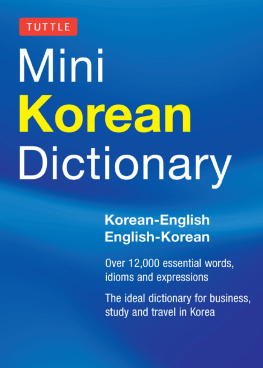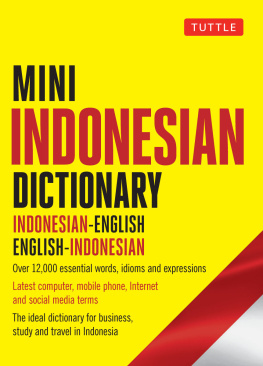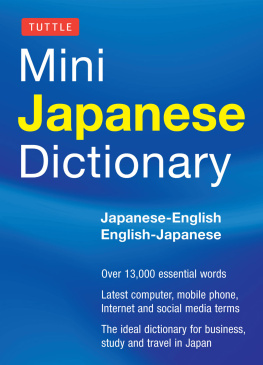MINIVietnameseDICTIONARYVIETNAMESE -ENGLISHENGLISH- VIETNAMESE Phan Van Giuong  Published by Tuttle Publishing, an imprint of Periplus Editions (HK) Ltd. www.tuttlepublishing.com 2020 by Periplus Editions (HK) Ltd All rights reserved. ISBN 978-1-4629-2114-0 Distributed by: North America, Latin America and Europe Tuttle Publishing 364 Innovation Drive, North Clarendon, VT 05759-9436 USA. Tel: 1(802) 773-8930 Fax: 1(802) 773-6993 Asia Pacific Berkeley Books Pte. Ltd. Introduction This Mini Dictionary is an indispensable companion for those who are working in Vietnam and learning Vietnamese. Introduction This Mini Dictionary is an indispensable companion for those who are working in Vietnam and learning Vietnamese. Published by Tuttle Publishing, an imprint of Periplus Editions (HK) Ltd. www.tuttlepublishing.com 2020 by Periplus Editions (HK) Ltd All rights reserved. ISBN 978-1-4629-2114-0 Distributed by: North America, Latin America and Europe Tuttle Publishing 364 Innovation Drive, North Clarendon, VT 05759-9436 USA. Tel: 1(802) 773-8930 Fax: 1(802) 773-6993 Asia Pacific Berkeley Books Pte. Ltd. Introduction This Mini Dictionary is an indispensable companion for those who are working in Vietnam and learning Vietnamese. Introduction This Mini Dictionary is an indispensable companion for those who are working in Vietnam and learning Vietnamese. It contains all the 15,000 or so Vietnamese words that are most commonly used in everyday communication. For the sake of clarity, only the common Vietnamese equivalents for each English word have been given. When an English word has more than one possible meaning, with different Vietnamese equivalents, each meaning is listed separately, with a clear explanatory gloss. The layout is clear and accessible, with none of the abbreviations and dense nests of entries typical of many small dictionaries. Vietnamese is the official language of Vietnam and is also used in neighboring regions of Cambodia and Laos and by substantial overseas Vietnamese communities. It has over 86 million speakers. Centuries of close cultural contact and linguistic influence have obscured the question of whether it is fundamentally related to Cambodia and the Mon language of Thailand and Burma, or to Lao and Thai. From around the beginning of the Common Era until the 10th century Vietnam was politically and culturally dominated by China, and the earliest form of the Vietnamese writing system, dating from the 9th century CE, was borrowed from Chinese. From the 13th century it evolved into a distinctive form adapted to the representation of Vietnamese by the addition of phonetic markers, but this system was never very widely used. The current form of written Vietnamese was developed in the 17th century by French Jesuit missionaries. It was further refined in the 18th and 19th centuries and became widely known and used during the period of French colonization after 1864. Since liberation from Japanese occupation in 1945 and especially since the reunification of North and South Vietnam in 1976 it has become an important symbol of national pride under the name of quoc ngu (national language). Like Thai and Chinese, Vietnamese is a tonal language. There are three major dialectsNorthern, Southern, and Centralwhich differ quite markedly in pronunciation, although they are generally mutually intelligible. The Northern dialect distinguishes between six tones, the Southern between five, and the Central only four. The standard system of writing, followed in this dictionary distinguishes between all six tones by means of diacritical marks written over the vowels (or no mark in the case of the mid level tone). For further details, please see the separate section on Pronunciation. Notes The Vietnamese alphabetical order used in this dictionary is as follows: a, , , b, c, d, , e, , g, h, i, k, l, m, n, o, , , p, q, r, s, t, u, , v, x, y. Notes The Vietnamese alphabetical order used in this dictionary is as follows: a, , , b, c, d, , e, , g, h, i, k, l, m, n, o, , , p, q, r, s, t, u, , v, x, y. The order of the tones is as follows: (a) No tone, e.g. ma (b) Low-falling, e.g. m (c) Low-rising, e.g. m (d) High-broken, e.g. m (e) High-rising, e.g. m Words in brackets ( ) are used to clarify or explain the meaning of the word, e.g. n rc to receive (someone). n rc to receive (someone). The numbers I, II after Vietnamese entries indicates words of the same form but have different meanings, e.g. baI N father, daddy, dad II NUM three. The list of abbreviations used in this dictionary is as follows: | ABBREV | abbreviation | | ADJ | adjective | | ADV | adverb | | CONJ | conjunction | | EXCLAM | exclamation | | GR | greeting | | INTERJ | interjection | | N | noun | | NUM | numeral | | P | particle | | PL | plural | | PREP | preposition | | PRON | pronoun | | SING | singular | | V | verb |
Pronunciation The Vietnamese alphabet has 29 letters: a, , , b, c, d, , e, , g, h, i, k, l, m, n, o, , , p, q, r, s, t, u, , v, x, y. Vietnamese consonants are written as a single letter or a cluster of two or three letters, as follows: b, c, ch, d, , g, gh, gi, h, k, kh, l, m, n, ng, ngh, nh, p, ph, qu, r, s, t, th, tr, v, x. The vowels in Vietnamese are the following: a, , , e, , i/y, o, , , u, . Vowels can also be grouped together to form a cluster. The following lists the consonants and vowels with their Vietnamese pronunciation followed by their English equivalent. Consonants | VIETNAMESE | ENGLISH | EXAMPLE | MEANING | | b | b ook | bt | pen | | c, k | c an | c | fish | | kem | ice-cream | | qu | qu een | qu | precious | | ch | ch ore | cho | to give | | d, g | z ero | da | skin | | (before i) | g | what | | d o | i | to go | | g, gh | g o | ga | railway | | ghe | boat | | h | h at | hai | two | | kh | (no real English Equivalent) | khng | no | | l | l ot | lm | to do | | m | m e; hi m | mai | tomorrow | | n | n ot; i n | nam | south | | ng, ngh | si ng er | ngon | delicious | | nghe | to hear | | nh | ca ny on | nho | grape | | Ph | ph one | phi | right | | r | r un | ra | |
|















 Published by Tuttle Publishing, an imprint of Periplus Editions (HK) Ltd. www.tuttlepublishing.com 2020 by Periplus Editions (HK) Ltd All rights reserved. ISBN 978-1-4629-2114-0 Distributed by: North America, Latin America and Europe Tuttle Publishing 364 Innovation Drive, North Clarendon, VT 05759-9436 USA. Tel: 1(802) 773-8930 Fax: 1(802) 773-6993 Asia Pacific Berkeley Books Pte. Ltd. Introduction This Mini Dictionary is an indispensable companion for those who are working in Vietnam and learning Vietnamese. Introduction This Mini Dictionary is an indispensable companion for those who are working in Vietnam and learning Vietnamese.
Published by Tuttle Publishing, an imprint of Periplus Editions (HK) Ltd. www.tuttlepublishing.com 2020 by Periplus Editions (HK) Ltd All rights reserved. ISBN 978-1-4629-2114-0 Distributed by: North America, Latin America and Europe Tuttle Publishing 364 Innovation Drive, North Clarendon, VT 05759-9436 USA. Tel: 1(802) 773-8930 Fax: 1(802) 773-6993 Asia Pacific Berkeley Books Pte. Ltd. Introduction This Mini Dictionary is an indispensable companion for those who are working in Vietnam and learning Vietnamese. Introduction This Mini Dictionary is an indispensable companion for those who are working in Vietnam and learning Vietnamese.